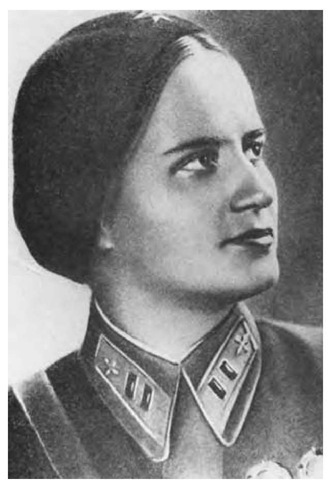One of three Soviet women’s air wings formed by Marina Raskova in October 1941 when male Soviet aircrews were unavailable and combat aircraft were outdated. An integral part of Soviet Air Defense Forces fighter aviation, the 586th flew Yak-series fighter aircraft. Tasked with protecting fixed targets from enemy attacks, the unit was subordinated at various times to the 144 th and 101st Fighter Aviation Divisions and the 9th Fighter Aviation Corps. In the course of 4,419 combat sorties, the regiment destroyed 38 enemy aircraft and damaged 42 in 125 air engagements (Pennington 2003, 520). It supported the Battle of Stalingrad and defended Voronezh, Kursk, Kiev, Debrecen, Budapest, and Vienna from enemy air attacks. It was most active during the middle period of the war, while based near Voronezh and Kursk.
Marina Raskova, commanding officer of the Soviet 586th Dive Bomber Aviation Regiment.
Despite including top-ranked pilots, the regiment received little recognition both during and after the war. Three members of a well-known prewar women’s aerobatic team flew with the regiment: Raisa Beliaeva, Valeriia Khomiakova, and team leader Evgeniia Prokhorova. Fighter aces Lidiia Litviak and Katia Budanova were former members of the regiment, which had a very troubled history. The deaths of the first three women mentioned are controversial, as was the transfer of its first commander, Tamara Kazari-nova. The unit failed to achieve the elite Guards status, and its pilots never received a single Hero of the Soviet Union award.
The 586th began active service at Saratov, near Stalingrad, on April 16, 1942, under the command of Major Kazarinova, who was later transferred to Air Defense Headquarters following the accidental death of Khomiakova during a night sortie in October 1942. Most of the veterans blamed Kazarinova for the accident. Kazari-nova was unpopular and became resentful toward her subordinates, especially after several women pilots sought her removal. She later reputedly took advantage of her staff position to make sure that those seeking her removal received particularly hazardous assignments, and she prevented the unit from gaining the prestigious status of Guards.
On September 10, 1942, Kazarinova sent eight pilots to Stalingrad; their squadron was split into two sections and sent to two different regiments. Among the eight were Lidiia Litviak and Ekaterina Budanova, future aces, but the 586th did not receive credit for their kills (enemy aircraft they shot down). Four of the eight returned within a few months; one perished in Stalingrad. Litviak, Budanova, and An-tonina Lebedeva were killed during the summer of 1943 while serving with various men’s regiments.
In October 1942 the regiment acquired another squadron staffed by male pilots, as well as a new permanent commanding officer, Alek-sander Gridnev. From February 13 to August 16, 1943, the unit was based at Voronezh. This was a very busy period during which pilots Raisa Surnachevskaia and Tamara Pamiatnykh engaged forty-two German bombers and shot down four, thus preventing bombs from being dropped on troop trains passing through the important rail junction at Kastornaia en route to the decisive Battle of Kursk. Surnachevskaia and Pami-atnykh were rewarded with inscribed gold watches by King George VI of England, but they received no Soviet recognition. The regiment also flew high-profile missions escorting important people such as Nikita Khrushchev, then political officer for the Stalingrad front, and Air Defense Forces Commander Major-General Gromadin.
Among the more prominent pilots who died while serving with the regiment were: Raisa Beliaeva (b. December 25, 1912; d. July 19, 1943, at Voronezh), senior lieutenant, pilot, and squadron commander. A member of a prewar aerobatic team, she participated in the Battle of Stalingrad and escorted Khrushchev’s aircraft. Gridnev, her commanding officer, considered her to be a top-rate pilot. Beliaeva’s death is attributed to aircraft malfunction.
Valeriia Khomiakova (b. August 2, 1914; d. October 6, 1942, at Saratov), pilot and deputy squadron commander. A member of a prewar women’s aerobatic team, Khomiakova was the first woman to shoot down an enemy aircraft at night. On her first combat patrol, September 24, 1942, she destroyed a Ju-88 bomber over Saratov in a nighttime engagement. This was the first official kill credited to the 586th. Khomiakova died in a crash during a night flight on October 5-6, 1942, possibly as a result of being posted to night-alert duty when she was extremely tired.
Evgeniia Prokhorova (b. 1913; d. December 3, 1942, at Uralsk), senior lieutenant, pilot, and squadron commander. A leader of a prewar women’s aerobatic team and holder of several world records in prewar competitions, Prokhorova was considered a very competent military pilot. While participating in a fighter escort mission, she was compelled to land during a heavy snowstorm. She was found frozen to death the next day, trapped in her overturned plane.

